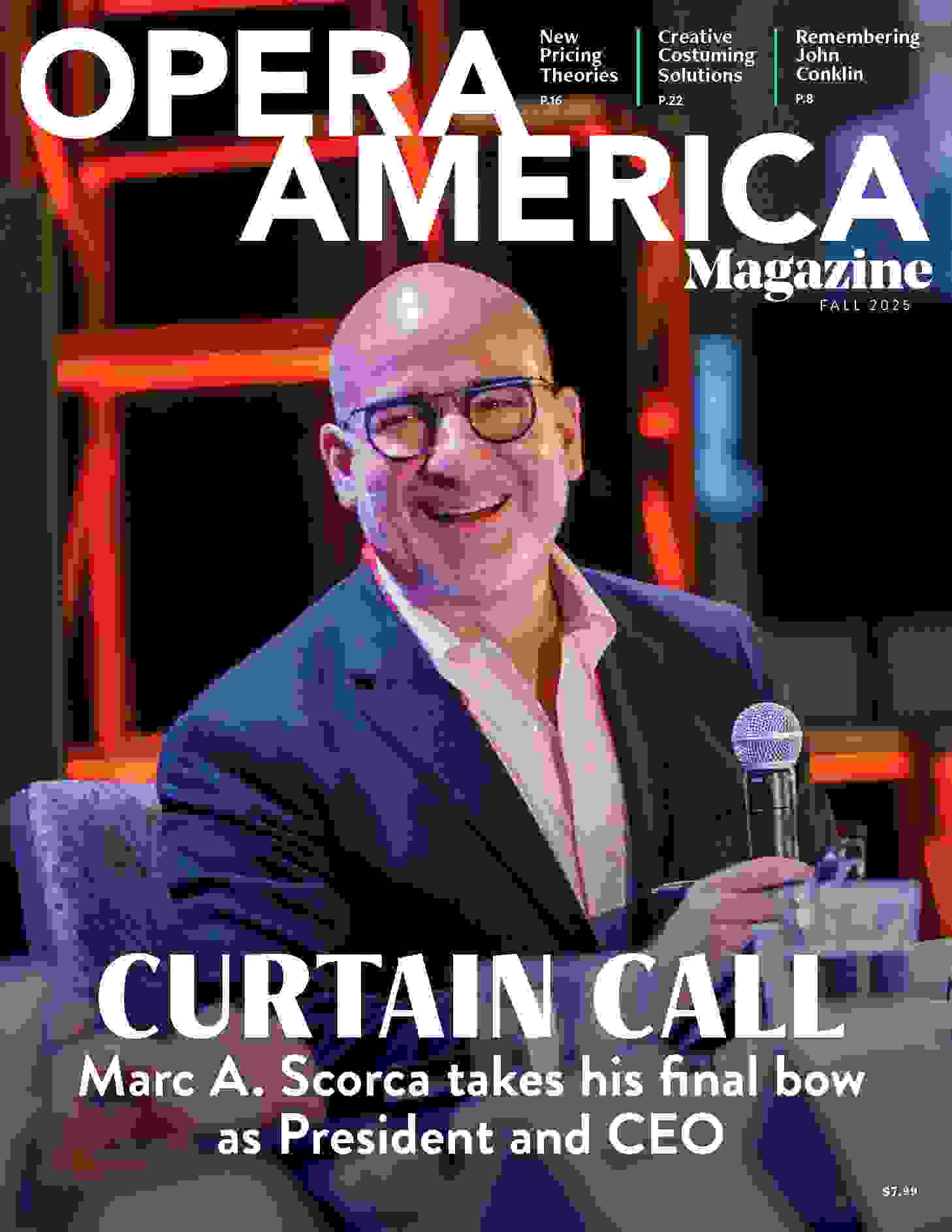A New Center
Some gauges of racial progress in opera are relatively simple to measure: It only takes cursory research to determine whether or not companies are engaging non-white artists and administrators or programming composers and librettists of color. But other measures are murkier. Do people of color working within opera feel that, in order to perform their jobs, they need to cater to white audiences, administrators, and boards? Are the operatic stories being told by and about Black, Asian, Latino, and Indigenous people novel and authentic, or do they fall into tired tropes known to resonate well with white viewers?
Answering these questions can bring the field closer to “decentering whiteness” — a concept that is now gaining increasing visibility within the sphere of opera and in the culture at large. “In order for us to decenter whiteness in opera, we have to acknowledge that most of how we approach the creation of opera, the evaluation of opera, the sharing of opera is influenced by the structure of whiteness and the culture of whiteness,” says Quodesia Johnson, education and company culture manager at The Dallas Opera.
Whiteness is “a construct of an imagination,” according to EDI expert and Equity Quotient CEO Keryl McCord. “Race is a political, social, and economic construct because it has no basis in science,” she says. “We’re 99.9 percent the same in our DNA. Science is saying that the differences in the way that people look — hair texture, color of your skin, shape of your nose, eyes, et cetera — all of that is a result of biogeography — where our ancestors lived.” But this observation in no way dampens the power of white supremacy as a social force, particularly in arenas that, like opera, have long been controlled by and aimed toward white people.
McCord describes an equity-training session in which one of the trainers asked, “What do white people bring to the table?” The answer: “The table. We know the shape, the size, how many it seats. It’s already been set.” Bringing new people to this institutional table — while an important and necessary endeavor — doesn’t necessarily alter its broader structure, which may still be inclined toward stories and perspectives that support the status quo. After centuries of American arts organizations showcasing works created by and for white audiences, decentering whiteness requires that people of color have the agency to create art without its primary goal being a favorable reception from white audiences.
The Black Opera Alliance, an organization of Black industry professionals founded by bass-baritone Derrell Acon, Long Beach Opera’s director of engagement and equity, is one of the groups trying to remake the table. The organization’s mission statement pledges to “empower Black classical artists and administrators by exposing systems of racial inequity and underrepresentation of the African diaspora in all facets of the industry.” According to Acon, simply improving diversity among opera artists, staff, and creators is not enough to create the necessary changes — there must be non-white people in power at the very top of the industry. When performers create works that must first earn the approval of almost exclusively white industry leaders before reaching audiences, it’s less likely that these works will seriously challenge gatekeepers’ comfort.
“Even when Black performers are invited to stages, even when Black designers or Black directors are invited to different spaces, if at the very top is some gatekeeper who happens to be white, who has the opportunity to say, ‘This is or is not something that’s going to work for our community,’ then you really don’t have anything that’s authentic,” says Acon. “You have something that is often whitewashed and something that is contrived.”
McCord recalls an occasion in which she was involved in a grant allocating process, and that, despite the organization’s intention to recruit diverse grantees, “We looked at the list of proposed projects to be funded and [they] were predominantly by white artists. This was the exact opposite of the results that we wanted. So we had to look at our policies.” The determination: The traditional grant writing process itself was the problem. It favored those with extensive arts industry experience or with the money to pay for personal grant writers — a disproportionately white cohort.
“Just because you’re an artist doesn’t mean you’re a grant writer,” says McCord. “You have to know the lingo. We were about to reward good grant writing, not rewarding the applicants that we knew were doing the work that this program was designed to support.” The organization decided to hold in-person meetings with applicants and to accept applications submitted via audio or video, as well as in writing.
While it’s important to stage productions of works by composers of color, and those created by and featuring artists of color, it would be entirely possible for such an all-POC endeavor to still aim primarily to appeal to white gatekeepers and satisfy white audiences, according to Quodesia Johnson. “We can have stories that are created by many people, but when it still centers the comfort, the attention, the emotional capacity and learning and knowledge of white audiences, that is still centering whiteness,” she says.
The current cultural reckoning around race has inspired in the arts a particular interest in stories about police brutality and racist violence — stories that these days can now feel especially relevant. But such works can themselves center whiteness, confining Black characters to limited roles as victims and tragic figures. “We deserve to have stories that tell the full human experience because we have a full human experience,” says Johnson. “That includes love stories, that includes comedies.”
According to bassoonist Garrett McQueen, a Black Opera Alliance leadership council member, the determining factor to gauge a work’s effectiveness in decentering whiteness is whether or not it attracts non-white audiences. Taking a more expansive approach to opera, one that includes music of non-European origin, may be one route to attracting new audiences to the form. “If we are going to allege to be American institutions with an American perspective on American music, we need to fully acknowledge and center Black music,” McQueen says.



While the idea of looking past the desires of a predominately white audience base may seem like a financial risk to some companies, Johnson sees it more as a matter of expanding opera’s scope. “Decentering does not mean removing everyone and everything, but to no longer place those values, those aesthetics, those cultures at the center of what defines opera,” Johnson says. “We have to trust that there’s enough space for everyone.”
Making opera hospitable to new audiences may involve interrogating the industry’s traditions, offstage as well as on. “Different communities gather in different ways,” notes Johnson. “Wine and cheese is not the thing for everybody. Some communities may want something different. Are you welcoming them into your space?”
In addition to broadening the scope of what is traditionally imagined as opera, decentering whiteness could also involve reconsidering the canon. Some works may fade from the repertoire. (“Mothball it,” says McCord of Porgy and Bess. “That is an opera for white people.”) Others might be reimagined in ways attractive to diverse contemporary audiences.
“We see so many of these traditional operas, especially in Europe, being reimagined and deconstructed,” says Acon. “I think we should do the exact same thing, but you use those topics that are at the center of community discourse. And a lot of them, frankly, have to do with race. They have to do with gender. They have to do with sexuality, with disability.”
One example of a transformative approach to the canon is Heartbeat Opera’s visual album Breathing Free, which debuted digitally this winter. The company had originally planned to remount its 2018 version of Fidelio, but it reworked its plan in light of the pandemic and the murder of George Floyd, opting to meld excerpts from Beethoven’s opera with music by Black composers like Harry T. Burleigh and Anthony Davis. “Our country and our industry just went into this huge moment of reckoning,” says Ethan Heard, Heartbeat’s co-artistic director and producer. “We saw an opportunity to continue our work on Fidelio, while folding in the music and writing of Black artists.”
To put together Breathing Free, Heartbeat enlisted a team of non-white creative collaborators, including a Black filmmaker and a Black creative producer. “These people were making crucial decisions about tone and perspective,” says Acon, who was featured as a performer on the album. “They told authentic stories that were not sullied by white gatekeeping.”
When Harriet Tubman: When I Crossed That Line to Freedom had its 2014 American Opera Project premiere, it became one of the few operas to bow with an all-Black team of creative leadership at the helm: Nkeiru Okoye, its composer and librettist; Leslie B. Dunner, its conductor; and the late Lemuel Wade, its director. The team’s racial makeup had not been part of the initial plan: Wade replaced a white director midway through the production’s preparation period. But Okoye says Wade’s work nonetheless brought advantages. “There were certain perspectives that he had that you don’t have if you’re from another culture,” she says.
A Truth Before Their Eyes, Okoye’s current operatic project, explores the lives of two Black women as they encounter medical racism — a life-or-death issue that, although it affects millions of Black Americans, receives less attention than more obviously violent forms of bigotry. “A lot of people think that racism is something that happens with the capital R,” says Okoye. “They’re thinking it needs to be an act of brutality, like kneeling on someone’s neck or shooting an unarmed person. They don’t understand that racism also exists as inherent bias.”
“If you say that Black lives matter, but you still treat me as someone who is not equal to you, you’re not only being hypocritical — you actually may be endangering my life,” says Okoye. “Saying, ‘I’m not prejudiced against Black people’ is very different than saying, ‘I’m not prejudiced against you.’”
The decentering movement’s radical reimagining of opera may well alienate some of the art form’s traditional audiences. “I’m not a Pollyanna,” says McCord. “Some people will leave. But that just makes space for people who aren’t afraid of not being the focus of attention.”
“Audiences may complain, ‘Oh, I can’t see Porgy and Bess or Madama Butterfly all the time like I wanted to,’” says Johnson. “We’re saying, ‘True, but here’s this other thing. Here are the individuals that you would have seen in these productions do their amazing work in other spaces.’” Johnson says that opera creators are more than capable of rising to the task of decentering. “This is an art form and we are creative individuals,” she says. “You’re not going to tell me you can’t find a solution.”
A Question of Representation
Earlier this year, OPERA America invited its Professional Company Members to distribute an anonymous Demographic Survey to their administrators and board members, allowing them to self-report information about age, race, and gender. To date, over 1,200 administrators and 1,400 board members from 97 companies have responded.
The findings so far show that the industry has a long way to go in achieving racial parity, with BIPOC individuals accounting for only 20.6% of staffs and 14.7% of boards. (The 2019 U.S. Census, by comparison, reports that the nation’s population is 39.9 percent BIPOC.)
These figures represent only an initial snapshot based on a select group of companies. Additional companies can submit data, with an aim of representing as many Professional Company Members as possible. Members of OA’s Racial Justice Opera Network, a group committed to dismantling racism in opera, are providing advice on the analysis and will assist in shaping future data-collection efforts.
Any Professional Company Members interested in participating in the survey can contact Alex Ganes, research manager, at AGanes@operaamerica.org.
This article was the recipient of the 2022 Azbee Silver Regional Award (Northeast) in the Diversity, Equity, and Inclusion category.
This article was published in the Summer 2021 issue of Opera America Magazine.

Gabrielle Bruney
Gabrielle Bruney is a New York-based arts and culture writer whose work has appeared in Esquire, Vice, and Jezebel.






